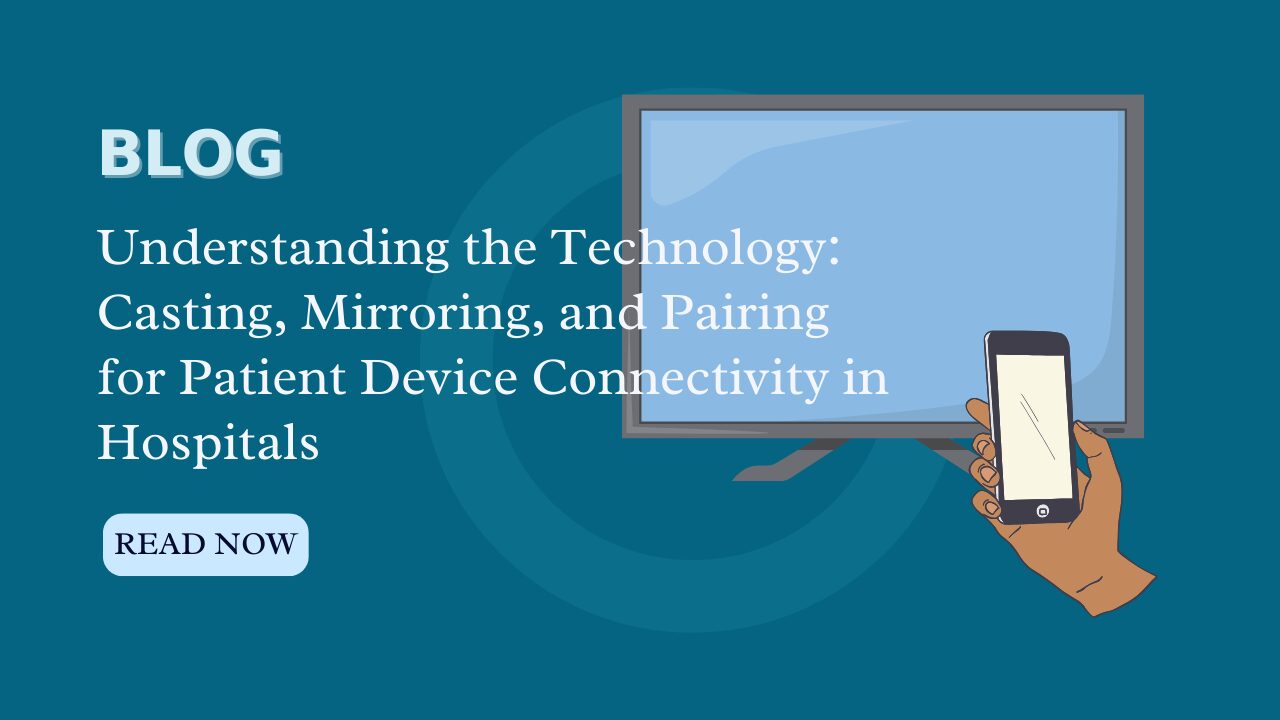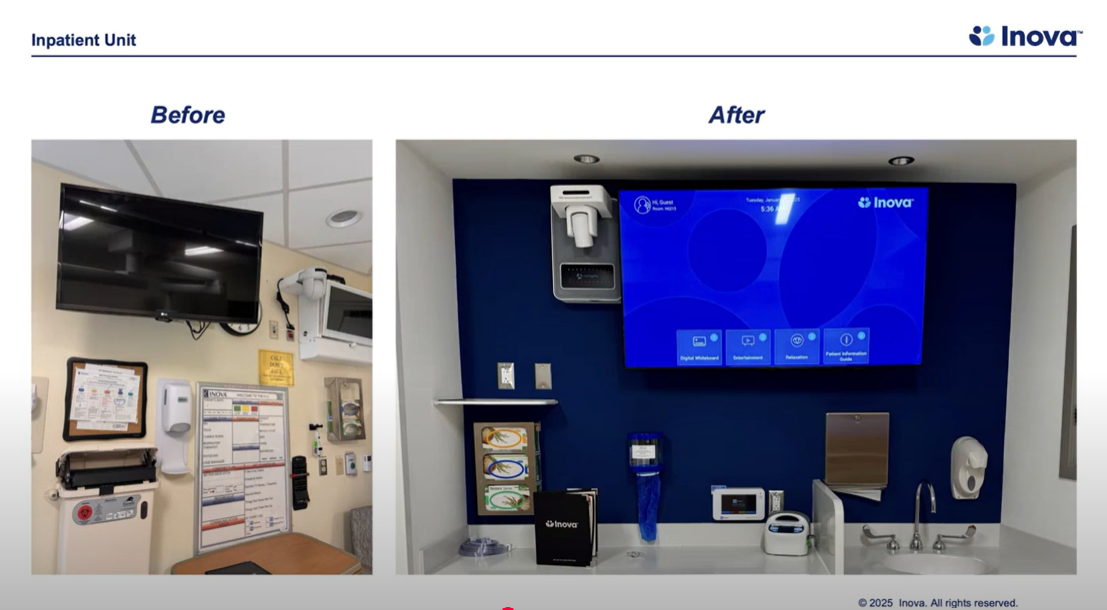In today’s hospitals, patients expect the same seamless connectivity they experience at home. Just as streaming content from our phones is effortless in familiar surroundings, many assume it should be equally simple during a hospital stay. As hospitals seek to provide home-like entertainment experiences, connecting personal devices like smartphones or tablets to in-room TVs is desirable. Three common methods—casting, mirroring, and pairing—facilitate this connectivity, each with its own distinctions and applications. When deciding which method is best, there are essential security and privacy factors you need to consider that differentiate connectivity in a hospital environment from a home.
Casting
Casting means solving the following problem: “I want to select videos, songs, movies, or other content from my personal device to a play on a Television in the same room.”
Casting involves wirelessly streaming content from a mobile device to a TV. Popular casting technologies include Google Chromecast and Apple AirPlay. In a hospital setting, casting allows patients to display their personal content such as videos, music, or third-party media content on the TV screen in their room. This method provides patients with a personalized and familiar entertainment experience.
Casting is typically initiated by having devices that are either “paired” or are connected to the same network and have undergone authentication. Importantly with casting, the content is not streamed from the mobile device itself. Instead, the casting protocol involves providing the display device with a content “location”, which it then uses to stream the content directly. The patient’s mobile device functions only as a media controller or remote.
Casting protocols can often have proprietary components or behavior – for example, Apple’s Airplay only functions on Apple devices, or devices that specifically license this technology. Google’s ChromeCast is also proprietary, although has broad support across both Google and Apple apps. Third-party applications can also enable casting by interfacing directly with applications that run on Smart Televisions. For example, when a patient launches content from Netflix on their mobile device and clicks the “Cast” button, the Smart TV will launch the “Netflix” application and play that content directly from the Smart TV app.
Key Characteristics of Casting
Unidirectional: Content streaming is initiated from the patient’s device to the TV.
Third-Party Devices: Requires compatible casting devices (e.g., Chromecast or AirPlay).
Content Control: Patients have control over the content displayed on the TV from their devices.
Mirroring
Mirroring means solving the following problem: “I want to show my exact screen, and any actions taken on it, on a television in the same room.”
Mirroring, also known as screen mirroring, duplicates the entire screen of a secondary device onto a TV. You might’ve used this technology if you’ve sat in a conference room for a presentation; often presenters will mirror their exact display on a projector or Television the entire audience can see.
Consumer Mirroring standards exist, such as MiraCast, but generally the technology has not reached the level of ubiquitous usage as casting standards like ChromeCast. Commercial mirroring solutions tend to be proprietary and do not perform as well nor meet a patient’s expectations for streaming content in a hospital and is not an approach we’d recommend for entertainment use cases.
Key Characteristics of Mirroring
‘Share Your Screen’: Displays everything from a patient device’s screen onto the TV.
Real-Time Reflection: Any activity on the device is immediately mirrored onto the TV.
Performance: Mirroring is not optimal for video content.
Pairing
Pairing means solving the following problem: “I have two-or-more devices which are usually/always in the same location that need to interact with or share the same resources.”
Pairing involves establishing a direct link, wirelessly, between a patient’s device and the TV using Bluetooth or a similar wireless technology. Pairing is often used for interactive purposes, such as controlling hospital room settings or accessing hospital-specific applications.
For example, Oneview leverages pairing in rooms with hospital provided patient tablets and televisions. These two devices are paired, allowing media controls (such as play, pause, mute) to appear on the tablet when it detects a movie has started on the patient’s Television. This provides an intuitive experience for patients that turns the tablet into a remote controller based on what they’re doing on the television.
Key Characteristics of Pairing
Direct Connection: Establishes a direct link between two devices.
Specific Use Cases: Primarily used for device control, specific applications, or launching content between devices.
Control only: Does not utilize consumer apps but depends on the entertainment offered on the TV.
Special Considerations for Healthcare
As hospitals grapple with changing patient expectations, they should not jump into device connectivity without considering healthcare workflows when enabling this connectivity. How a person engages with their connected devices at home is much different from how they should engage with connected devices in a shared space.
There are several situations to consider this in a hospital setting.
There are two hospital rooms next to one another, Room 101 and Room 102. This means there are two separate televisions connected to the same network. In a home, a person in this scenario might expect to be able to cast content to any device on their network. In healthcare, this situation is different. Mark is staying in Room 101 and should not be able to interact with the television in Room 102.
Now let’s imagine Mark is being discharged from Room 101 and later, Sally will be admitted to that room. It would be inappropriate for Mark to maintain access to casting on the television in Room 101 after he’s been discharged.
It’s important to remember that if a patient uses their own personal device, the hospital cannot restrict or limit what is displayed on the television screen. This is crucial when considering what patients can access on their phones and what staff members might see when entering the patient’s room. Although the patient room belongs to them during their stay, it remains a semi-public environment.
Given the type of content that is engaged with in a healthcare space, it is crucial that hospitals are engaging with vendors that can help them solve these problems in a way that meets the security and privacy expectations of their patients.
Recommendation
In conclusion, casting, mirroring, and pairing offer distinct methods for connecting patient devices to TVs in hospital rooms. It is crucially important to understand the terminology and protocols being used to understand how patients and their guests may expect to utilize devices while staying at your facilities.
Understanding the differences between these methods enables hospitals to tailor their patient entertainment and education systems to meet diverse patient needs and preferences. By offering the correct connectivity options for the way the system will be used, hospitals can enhance patient satisfaction and contribute to a more comfortable, engaging, and safe healthcare environment.
Feeling like none of this matches what you’re looking for? Check out MyStay Mobile – allowing patients to access hospital approved content on their own personal device.



